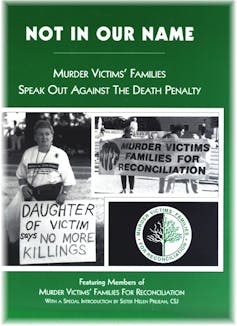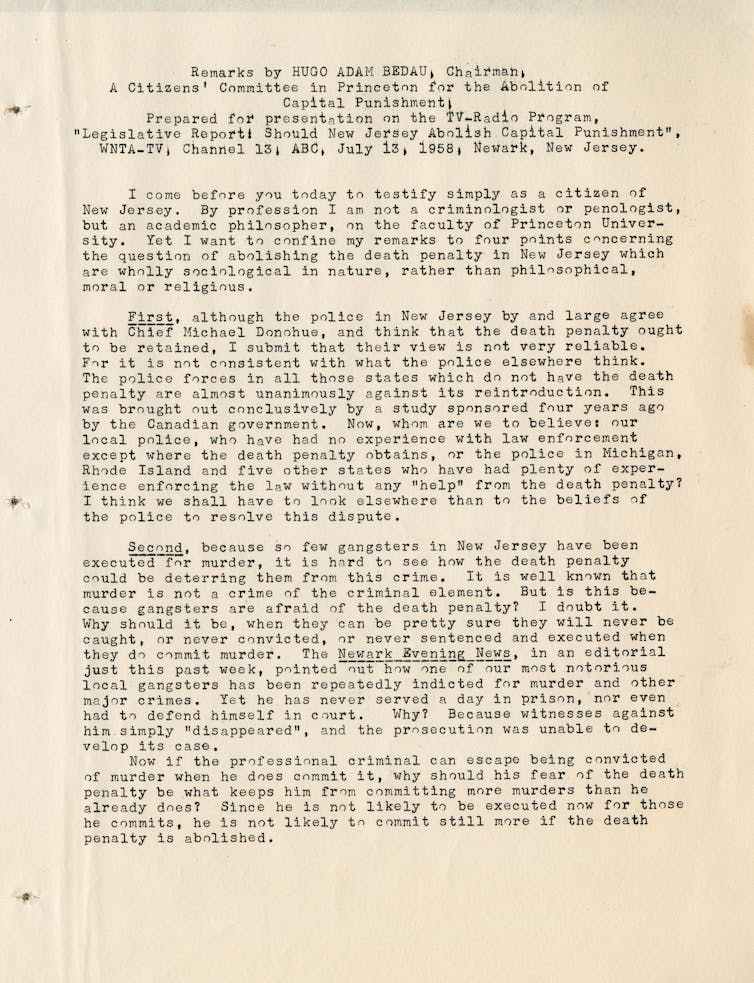The death penalty, an American tradition on the decline
- Written by James Acker, Distinguished Teaching Professor of Criminal Justice, University at Albany, State University of New York
Capital punishment has been practiced on American soil for more than 400 years. Historians have documented nearly 16,000 executions[1], accomplished by burning, hanging, firing squad, electrocution, lethal gas and lethal injection. An untold number of others have doubtlessly occurred yet escaped recognition.
 The book ‘Not in Our Name: Murder Victims Families Speak Out against the Death Penalty,’ published in 1997.
Murder Victims' Families for Reconciliation Records, University at Albany, CC BY-ND[2]
The book ‘Not in Our Name: Murder Victims Families Speak Out against the Death Penalty,’ published in 1997.
Murder Victims' Families for Reconciliation Records, University at Albany, CC BY-ND[2]
We helped create the University at Albany’s National Death Penalty Archive[3], a rich repository of primary source material encompassing the long and growing history of the death penalty.
Capital punishment has long been and continues to be controversial, but there is no disputing its historical and contemporary significance. More than 2,700 men and women[4] are currently under sentence of death throughout the U.S., although they are distributed in wildly uneven fashion. California’s death row, by far the nation’s largest, tops out at well over 700, while three or fewer inmates await execution in seven states.
Executions similarly vary markedly by jurisdiction. Texas has been far and away the leader over the last half century, with five times as many executions as the next leading state[5].
Prized archives
We established the National Death Penalty Archive to help preserve a record of the country’s past and current capital punishment policies and practices, and to ensure that scholars and the general public can gain access to this critical information.
The archive currently holds numerous collections from diverse sources[6], including academics, activists, litigators and researchers. We remain open to new donations of materials relating to capital punishment. The materials are stored in a climate-controlled environment and are accessible to the public.
One of our prized collections is the voluminous set of execution records compiled by M. Watt Espy Jr. Espy spent more than three decades, encompassing the 1960s into the 1990s, traversing the countryside, collaborating with others to uncover primary and secondary sources documenting more than 15,000 executions carried out in the U.S. between the 1600s and the late 20th century. Espy’s data set has since been updated to include information on executions through 2002.
The National Death Penalty Archive houses the court records, newspaper articles, magazine stories, bulletins, photographs and index cards created for each execution that Espy and his assistants painstakingly collected. These items vividly capture this unparalleled history of executions within the American colonies and the U.S.
Among those documented is the 1944 electrocution in South Carolina of George Stinney Jr.[7], who at age 14 was the youngest person punished by death during the 20th century. Seventy years later, a South Carolina judge vacated Stinney’s conviction, ruling that he did not receive a fair trial.
In July, after the documents are fully digitized, the National Death Penalty Archive will make all of Espy’s materials available online.
 Index card about George Stinney, created by death penalty historian M. Watt Espy.
M. Watt Espy Papers, University at Albany, CC BY-ND[8]
Index card about George Stinney, created by death penalty historian M. Watt Espy.
M. Watt Espy Papers, University at Albany, CC BY-ND[8]
Other papers
Another prized holding consists of nearly 150 boxes of materials from Eugene Wanger. As a delegate to the Michigan Constitutional Convention, Wanger drafted the provision prohibiting capital punishment that was incorporated into the state constitution in 1961.
For more than 50 years, Wanger compiled a treasure trove of items spanning the 18th through 21st centuries relating to the death penalty, including numerous rare documents and paraphernalia. Among the thousands of items in the extensive bibliography are copies of anti-capital-punishment essays written by Pennsylvania’s Benjamin Rush shortly after the nation’s founding.
We also have collected the work of notable scholars. For example, the National Death Penalty Archive houses research completed by the late David Baldus, known primarily for his analysis of racial disparities in the administration of the death penalty; the writings of the late Hugo Adam Bedau, perhaps the country’s leading philosopher on issues of capital punishment; and the papers of the late Ernest van den Haag, a prolific academic proponent of capital punishment.
The National Death Penalty Archive additionally contains more than 150 clemency petitions filed on behalf of condemned prisoners, as well as materials relating to notable U.S. Supreme Court decisions, including Ford v. Wainwright, prohibiting execution of the insane, and Herrera v. Collins, in which the justices were asked to rule that the Constitution forbids executing an innocent person wrongfully sentenced to death.
 Remarks by Hugo Bedau against the death penalty in 1958.
Hugo Bedau Papers, University at Albany, CC BY-ND[9]
Remarks by Hugo Bedau against the death penalty in 1958.
Hugo Bedau Papers, University at Albany, CC BY-ND[9]
On the decline
The recent history of capital punishment in the U.S. has been marked by declining popularity and usage. Within the past 15 years, eight states have abandoned the death penalty[10] through legislative repeal or judicial invalidation.
The number of new death sentences imposed annually nationwide has plummeted from more than 300 in the mid-1990s to a fraction of that – just 42 – in 2018. Last year, there were 25 executions in the U.S., down from the modern-era high of 98 in 1999[11].
Meanwhile, public support for capital punishment as measured by the Gallup Poll registered at 56 percent in 2018, compared to its peak of 80 percent in 1995[12]. Only a few counties, primarily within California and a few southern states, are responsible for sending vastly disproportionate numbers of offenders to death row[13].
What these trends bode for the future of the death penalty in the U.S. remains to be seen. When later generations reflect on the nation’s long and complicated history with the death penalty, we hope that the National Death Penalty Archive will offer important insights into the currents that have helped shape it.
References
- ^ nearly 16,000 executions (deathpenalty.procon.org)
- ^ CC BY-ND (creativecommons.org)
- ^ National Death Penalty Archive (library.albany.edu)
- ^ More than 2,700 men and women (deathpenaltyinfo.org)
- ^ five times as many executions as the next leading state (deathpenaltyinfo.org)
- ^ collections from diverse sources (library.albany.edu)
- ^ George Stinney Jr. (www.washingtonpost.com)
- ^ CC BY-ND (creativecommons.org)
- ^ CC BY-ND (creativecommons.org)
- ^ eight states have abandoned the death penalty (deathpenaltyinfo.org)
- ^ the modern-era high of 98 in 1999 (deathpenaltyinfo.org)
- ^ its peak of 80 percent in 1995 (news.gallup.com)
- ^ vastly disproportionate numbers of offenders to death row (deathpenaltyinfo.org)
Authors: James Acker, Distinguished Teaching Professor of Criminal Justice, University at Albany, State University of New York
Read more http://theconversation.com/the-death-penalty-an-american-tradition-on-the-decline-107948

